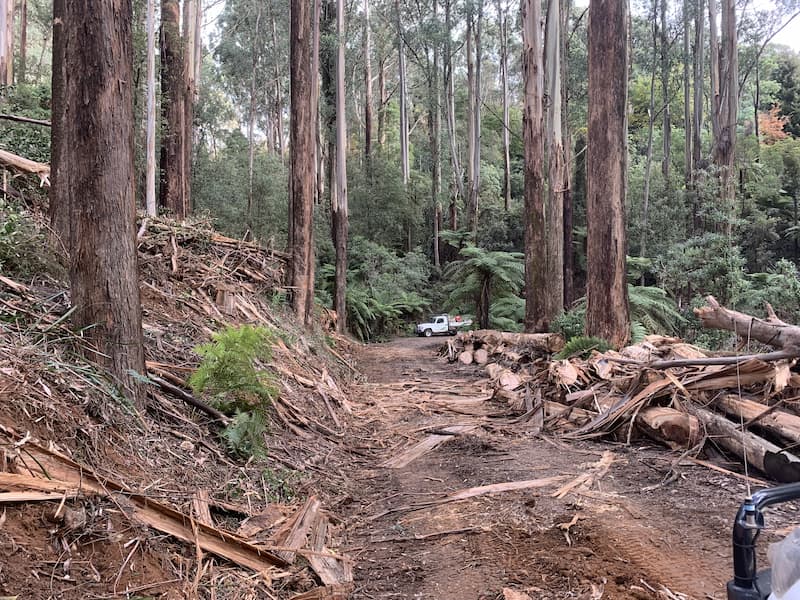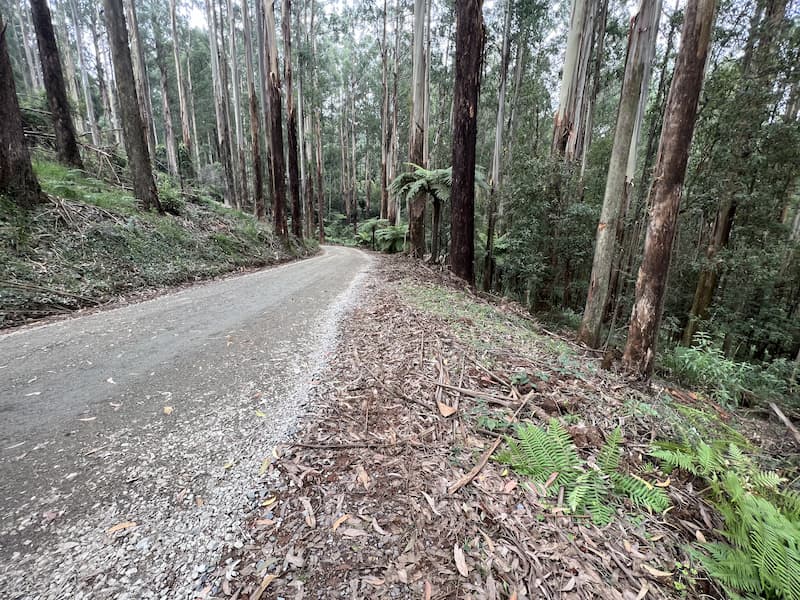Overview
More than 220 hectares of forested area was severely affected within the Dandenong Ranges National Park in the 2021 storms.
In some areas, as much as 90% of the tree canopy blew over or snapped off.
Forest Fire Management Victoria (FFMVic) has led the recovery effort in the Dandenong Ranges. Partners include Parks Victoria, Melbourne Water and Yarra Ranges Shire.
FFMVic is removing debris from tracks and roadsides to ensure safe access for firefighters and the community.
The works affect less than 1.5% (50 hectares) of the 3540-hectare Dandenong Ranges National Park.
These are not commercial timber harvesting operations.
Debris is only removed in areas where it creates a bushfire or other safety risk. Standing trees will only be removed where they have been assessed as hazardous and are a risk to safety.
Learn more about managing fire risk
Where appropriate, fallen trees are left for wildlife habitat.
Learn more about how we manage environmental values.
All roads, tracks and fuel breaks have been reopened.
Work is still taking place to treat hazardous debris around Kalorama and Olinda.
Before clean-up

After clean-up

What work is being carried out?
Fallen debris is being removed from roadsides along key fire access roads and fuel breaks.
This includes up to 40 metres either side of the tracks.
Standing trees will only be removed where they have been assessed as hazardous and are a risk to safety.
These works remove obstacles at the site. They allow fire crews to respond more quickly, safely and effectively to a bushfire.
The works ensure a safer work environment for crews conducting planned burns. They also allow crews to conduct most of the work from the existing tracks.
Find out more about the works to clean up the storm debris in these locations by clicking on the interactive map below.
Why are the works taking place?
The amount of storm debris in these areas increases the potential bushfire severity and risk to the community. It would also make controlling a bushfire very challenging.
Where are works taking place to reduce risk?
Track 13, near Silvan Reservoir Park, Silvan. For the latest updates on track closures within the National Park, visit Dandenong ranges national park.
When will these works take place?
For updates on delivery, please refer to the interactive map.
What is happening to the debris once it's removed from the park?
Debris has been made available for firewood collection near Powelltown.
Fallen hollow logs and rootballs were provided for:
- fish habitat along streams
- habitat in Lysterfield Lake Park
- Werribee Zoo animal enclosures, and more.
Parks Victoria and Zoos Victoria have used finished timber products for bollards, sleepers, log seats, mulch, picnic tables and tree stakes.
What progress has been made so far?
- 33.4 hectares out of 71.7 hectares has been treated to date
- hazardous trees have been removed from 350 km of roads, and roads reopened
- 100 artificial hollows/nest boxes installed
- 10 recreation areas have been reopened
- 9 walking tracks (60 km) reopened.
Storm debris locations on interactive map
The pins on the map show you:
- roadside works in purple - horizontal hatching
- broadacre works in orange - vertical hatching (broadacre means works in areas beyond roads and tracks).
If you zoom in, you will see the hatched area and the boundary of each treatment site.
Clicking on a pin or a hatched area, will provide you with information about a site, including:
- a unique site number
- the name of the location of where works are taking place, usually relating to a road or track
- which organisation they are being done for, usually DEECA and sometimes on behalf of a land manager
- a description of the status of the works, with an estimated start or finish date for the works (if available).
Please note that the hatched area on the map is the total site area. The area that timber is being removed from is generally only part of the site area.
The maps will be updated as value checks are finalised and assessed in the field.
Please note: The hatched area on the map is the total site area. The treatment area that debris is being removed from is generally only part of the site area.
In State forests, Public Safety Zones will be put in place before works begin on any site. This restricts access to make sure everyone is safe while heavy machinery is in the area. It is an offence to enter a Public Safety Zone. For works in National Parks, Parks Victoria will manage closures.
What is the bushfire risk in the Dandenongs?
The Dandenong Ranges is heavily populated. Many people live in or near the forest with few escape routes. The nearby Silvan Reservoir provides 82% of Melbourne's drinking water, which would be at risk in a major bushfire in the area.
A bushfire in this area could significantly impact:
- people
- biodiversity and wildlife
- critical infrastructure including water catchments, and
- the local economy.
For these reasons, the Dandenong Ranges has the highest bushfire risk in the Greater Melbourne region.
How do you protect the environment during these works?
We prioritise the protection of environmental, biodiversity and cultural values during all recovery and bushfire risk reduction works.
Learn more about how we manage environmental values.
Apart from debris removal and planned burns, how do you manage fire risk?
We work year-round alongside partner agencies, local government and communities to develop and deliver the Joint Fuel Management Plan (JFMP).
As well as planned burning, we lower bushfire risk by:
- slashing
- mulching or
- removing excess vegetation.
Useful links
Page last updated: 28/09/24